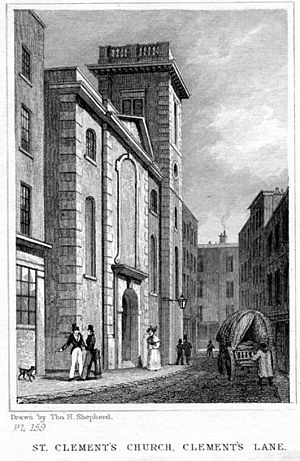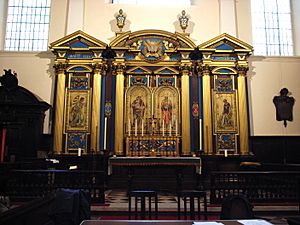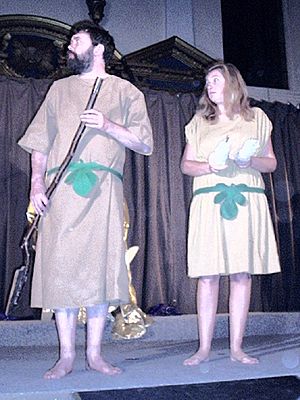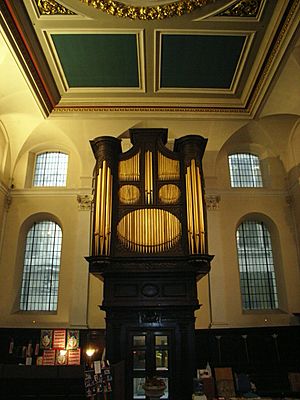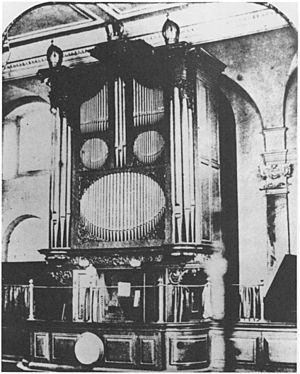St Clement's, Eastcheap facts for kids
Quick facts for kids St Clement Eastcheap |
|
|---|---|
| St Clement Eastcheap Clements Lane, London |
|
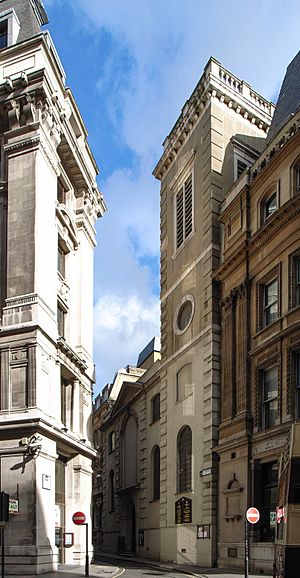
St Clement's Church, October 2006
|
|
| Location | London, EC3 |
| Country | United Kingdom |
| Denomination | Church of England |
| Previous denomination | Roman Catholic |
| Website | Official website: http://www.london.anglican.org/about/explore-the-diocese/parish/st-clement-eastcheap |
| History | |
| Founded | pre. 1067 |
| Dedicated | 1687 |
| Architecture | |
| Heritage designation | Grade I listed building |
| Architect(s) | Sir Christopher Wren |
| Years built | 1683 (begun) |
| Administration | |
| Parish | St Clement, Eastcheap |
| Diocese | London |
| Division | Archdeaconry of London |
| Subdivision | City Deanery |
St Clement Eastcheap is a Church of England church in the City of London. It stands on Clement's Lane, near King William Street, London Bridge, and the River Thames.
The church is named after Saint Clement, who was an early leader of the Christian church. Legend says he was tied to an anchor and thrown into the Black Sea. Because of this, he became known as the patron saint of sailors. There are only two old churches in London named after Saint Clement. The other is St Clement Danes in Westminster. Both churches are mentioned in the children's nursery rhyme "Oranges and Lemons".
Contents
History of St Clement Eastcheap
Early Beginnings
Eastcheap was a busy street in medieval London. The name 'Eastcheap' comes from an old word meaning 'market'. It was called Eastcheap to tell it apart from Westcheap, which is now Cheapside. Clement's Lane used to open onto Eastcheap. This changed in the 1880s when King William Street was built.
The church's name, linked to a saint of sailors, and its location near old Roman docks, suggest it might have Roman roots. Roman remains, like thick walls and tiled floors, were found deep underground in Clement's Lane.
A document from 1067, given by William the Conqueror, mentions a St. Clement's church. This might be St Clement Eastcheap. The first clear mention of the church is from the time of King Henry III (1207–1272). It was called 'St Clement Candlewickstrate' then. Other old papers called it 'St Clement the Little by Estchepe'.
For a long time, the Abbot of Westminster chose the church's priest. After King Henry VIII closed the monasteries, the Bishop of London took over. Today, the Bishop of London and the Dean and Chapter of St Paul's take turns choosing the new priest.
The church was repaired in 1630 and 1633, according to a historian named John Strype.
Destruction and Rebuilding
In 1666, the Great Fire of London destroyed St Clement Eastcheap. It was rebuilt in the 1680s. Sir Christopher Wren, a famous architect, is believed to have designed the new church. Records show that he received a gift of wine from the parish in 1685. Edward Strong the Elder was the builder.
After the fire, in 1670, St Clement's parish joined with St Martin Orgar. St Martin Orgar's church was also ruined, but its tower survived. French Huguenots used St Martin's tower for worship until 1820. Later, the rest of St Martin's church was removed to make way for Cannon Street. The tower was replaced with a new one in 1851. This new tower served as a home for St Clement's priest until the 1970s. It is still there today on Martin Lane.
Building St Clement's church started in 1683 and finished in 1687. It cost £4,365.
Changes in the 1800s
In the 1830s, St Clement's church was almost torn down. Many City churches faced this threat. This was because fewer people lived in the City of London. They were moving to the suburbs.
St Clement's was saved, but many other City churches were destroyed. This happened especially after the Union of Benefices Act of 1860. This law aimed to reduce the number of churches in the City.
In 1872, William Butterfield, a well-known architect, updated St Clement's. He removed the galleries and replaced the plain windows with stained glass. He also changed the reredos (the screen behind the altar) and added new pews. The floor was covered with colorful tiles, and the organ was moved.
The 1900s and Today
In 1933, another architect, Sir Ninian Comper, made more changes. He moved the organ back to its original spot. He also put the reredos back behind the altar and had it painted with blue and gold figures.
During the London Blitz in 1940, German bombs caused minor damage to St Clement's. The repairs were done in 1949–50. The church was redecorated again in 1968.
Today, St Clement's holds weekly services. From 1998 to 2011, a theatre group called The Players of St Peter performed medieval plays there. They now perform at St George in the East church.
Some charities have their offices at St Clement's. The Cure Parkinson's Trust was based here for several years.
"Oranges and Lemons" Rhyme
St Clement Eastcheap believes it is the church mentioned in the nursery rhyme "Oranges and lemons / Say the bells of St Clement's". However, St Clement Danes Church in Westminster also claims to be the church in the rhyme. Its bells play the tune of the rhyme three times a day.
Some people thought the rhyme was first mentioned in a book from 1511. But that book only had riddles and did not mention bells or St. Clement.
According to researchers Iona and Peter Opie, the earliest record of the rhyme is from around 1744. However, a dance called 'Oranges and Limons' appeared in a music book in 1665.
St Clement Eastcheap's claim is that it was close to where citrus fruits were unloaded from ships. But many other churches were even closer to the River Thames. It seems more likely that the name St. Clements was chosen for the rhyme because it sounded good with 'lemons'. The melody might even be older than the rhyme itself.
Church Building
St Clement Eastcheap has an unusual shape. The main part of the church, called the nave, is mostly rectangular. But the south aisle (a side section) gets much narrower. The ceiling has panels, with a large oval of fruit and flowers in the middle.
The main entrance is on the west side, facing Clement's Lane. It has a door with a rounded window above it. The tower is on the southwest side. It is a simple square tower without a spire. The church walls are covered in stucco, except for the top parts of the tower where the brick shows.
A small churchyard remains to the east of the church. It is surrounded by office buildings. Old tombstones are there, but their writing is hard to read now. A narrow path along the north wall leads to the churchyard. At the entrance, there is a plaque for Dositej Obradović, a Serbian scholar who lived nearby.
The church was officially named a Grade I listed building on January 4, 1950. This means it is a very important historic building.
Organ
The organ in St Clement's has an oak case from 1696. It was made for the original organ by Renatus Harris. The organ itself has been rebuilt and repaired many times over the years.
In 1872, as part of the church's renovation, the organ was moved from the west gallery to the south aisle. In 1936, it was moved back closer to its original spot at the west end. The organ was last cleaned and repaired in 2004.
Organists
The first known organist was Henry Lightindollar, who started in 1699. Other organists included Edward Purcell, son of the famous composer Henry Purcell. Edward Purcell was organist from 1711 until he died in 1740. His son, Edward Henry Purcell, then took over until 1765.
The current organist (as of September 2008) is Ian Shaw.
Church Furnishings
The altar, with cherubs as legs, is from the 1600s. The reredos behind the altar was decorated in the 1930s. It shows the Annunciation (when an angel told Mary she would have Jesus). The middle part shows St. Clement and St. Martin of Tours.
The pulpit, where sermons are given, is also from the 1600s. It is made of Norwegian oak and has a hexagonal top with cherubs.
From the 1872 renovation, the colorful floor and three stained glass windows on the north wall remain. These windows show different saints like St. Andrew and St. Peter.
The marble font, used for baptisms, has a beautiful wooden cover. This cover has a carved dove with an olive branch, surrounded by golden flames. It is said that William Ewart Gladstone, a former Prime Minister, loved it so much he took his grandchildren to see it.
Famous People Connected to the Church
Thomas Fuller, a writer, gave sermons at St Clement's in 1647.
The famous diarist John Evelyn heard John Pearson preach here. Pearson was the weekly preacher from 1654. His sermons at St Clement's later became a book called An Exposition of the Creed. He dedicated it to the people of St. Clement's, Eastcheap.
One of the church's rectors, Benjamin Stone, was put in prison by Oliver Cromwell because he was thought to be "too Popish." He later got his freedom and returned to the church when King Charles II became king again.
Samuel Pepys, another famous diarist, wrote about hearing a sermon by Josias Alsopp at St Clement's in 1661. He said Alsopp was "indeed an able man."
There are also memorial plaques in the church for past clergy members. These include Rev. Thomas Green, Rev. John Farrer, and Rev. W. Valentine Ireson.
Memorial
Next to the church on Clement's Lane is a memorial stone for Dositej Obradović (1742–1811). He was a Serbian statesman and writer who became Serbia's first Education Minister. He lived in a house near the church in 1784. His name on the plaque is spelled Dositey Obradovich.
Images for kids



